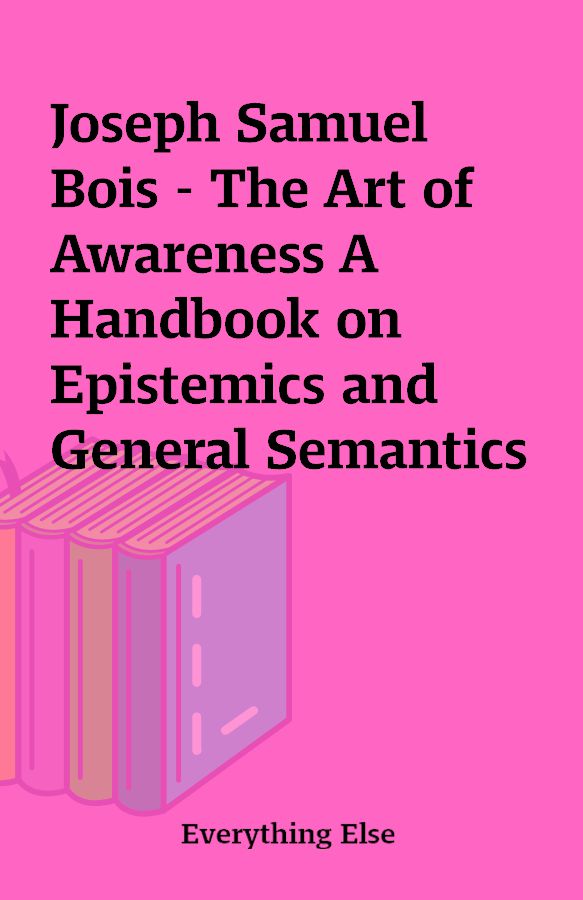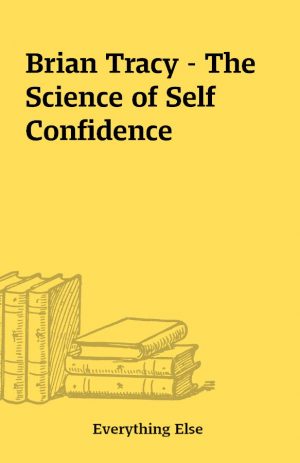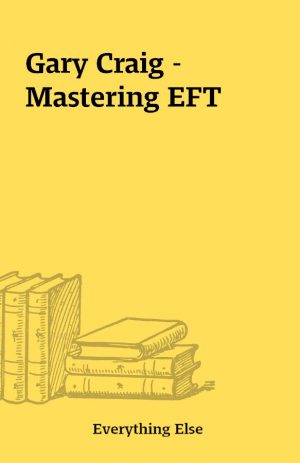Joseph Samuel Bois – The Art of Awareness A Handbook on Epistemics and General Semantics
Joseph Samuel Bois – The Art of Awareness A Handbook on Epistemics and General Semantics
[ 1 PDF , 1 JPEG ]
Description
**** elib.tech Exclusive ****Help us keep elib.tech all the more special for its exclusivity.Out of respect for the original authors and publishers,please do not make this product available outside of our community.Thanks for keeping elib.tech awesome! GB Status : CLOSED GB Page : Joseph Riggio – Finding Your Essential Self GB J. Samuel Bois formulated The Art of Awareness over a period of sixteen or seventeen years. Originally published in 1966 as a textbook in general semantics by the William C. Brown Co., it has been through three editions. In 1933 Alfred Korzybski introduced the new human science which he called general semantics without reflecting on the possible shrinking of the field he was introducing due to the confusion around the term “semantics.” This term mislead many to limit his work to communications and language usage. The second edition of The Art of Awareness disspelled that confusion by introducing epistemics as a further development of general semantics. This edition continues that development.Technically speaking, epistemics can be described as applied epistemology. Epistemology is the science of our meaning activities; it involves inquiries into how we know what we know, and what are the core assumptions that hold our knowledge of the world, including ourselves, together in a way that makes sense to us. Each culture does this in a unique way. Epistemology, in our growing humility, attempts to put some order in the “towers of babble.”Korzybski wrote in his influential work, Science and Sanity, “Not every individual knows or realizes the importance of, or seemingly consciously cares for epistemology; yet every one unconsciously has one and acts and lives by it. Each individual has his own special problems, the solution of which always claims the whole man, and no man is complete, unless he consciously realizes the permanent presence in his life of some standards of evaluation. Every one has thus some epistemology. There is no way of parting with it—nor with air, nor with water- and live. The only problem is whether his standards of evaluation are polluted with primitive remains of bygone ages, in a variety of ways .”Samuel Bois’ purpose in developing epistemics was to make the “wisdom of the ages” available to the nontechnical person as well as professionals in psychology, the sciences, education, and the arts. The wisdom being made available was an awareness of our limitations in making sense of what is going on within and outside of us; that we are never just observers but involved participants in whatever we experience; that life goes on as a whole; and that the differences and similarities we distinguish and perceive “out there” are the results of our attempts to further our purposes or to measure – they are not inherent in the processes we are paying attention to.Recent developments in epistemics have shifted its emphasis to communion as an art, rather than emphasizing the evaluative, and communication of information processes as general semantics was prone to do. Those aspects are still the basics, but the realm that epistemics covers in addition is the interface (the worlds in which we live) between the movements that shape all life forms (the formative tendency) and the manifest world of appearances as we humans see it. Bois wrote in a letter, “(The) ultra-modern science as I practice it is not alien to what we call simple faith and religious ritual. Lived in participating awareness, these add the glow and the warmth of educated feeling to the well articulated structure of acquired knowledge.””Participating awareness” is a good way to describe the activity of epistemics in action. This kind of awareness does not seek to teach, correct, or change. By its presence, its insights will participate in any activity and modestly bring another kind of order to it; an order that can allow us to loosen our distressed grip on what concerns us. In this way a kindly awareness, not a threateningly confrontive one, emerges between what we say and do. We then have available what we sense at the silent levels of our hearts where we are at one with the whole of existence.https://www.amazon.com/Art-Awareness-Handbook-Epistemics-Sem…Quote:Bois was a French Canadian Jesuit priest who was forced out of the Church in the 1920’s for his radical, against-doctrine views. It is interesting that while our other great writer Teilhard de Chardin did not have to leave the Catholic priesthood, his work was not fully appreciated by his superiors either. After Bois left the Church he got a degree in psychology from McGill University in Canada. As he was born in Quebec, French was his first language. In the late 1930s, he read Alfred Korzybski’s ‘Science and Sanity’ and was shaken by it. The foundation of his primary assumptions about our humanness was rocked, so he went and studied with Korzybski and became his most adventurous student. Korzybski had started the Institute of General Semantics (IGS), first in Chicago, and later in Lakeland, Connecticut. After he died, Bois became the heir apparent, and was the chief lecturer. Bois took seriously Korzybski’s statement in ‘Science and Sanity’: ‘In the present work, each statement is merely the best the author can make in 1933. (So) we ought not to be surprised if such a pioneering enquiry proves to need many corrections and elaborations in the future’. Bois developed his own work, epistemics, as a further elaboration of what Korzybski started, and as a new development that introduced factors which warranted calling it a new discipline. There is an annual Korzybski Memorial address, and LL Whyte was the speaker one year. After a successful career as a management consultant using general semantics, Bois started his own institute called Viewpoints. Because of the influence of Bois, Philosphere Publishers []was set up after his death
You must be logged in to post a review.






Reviews
There are no reviews yet.